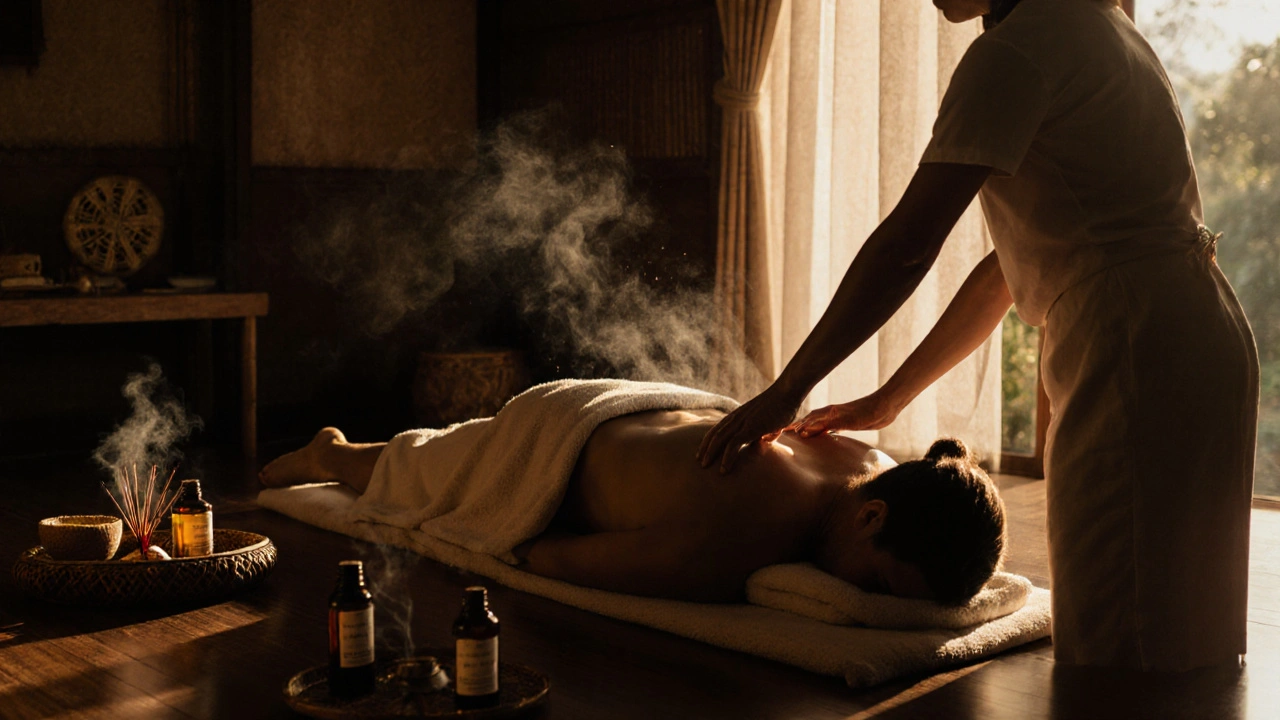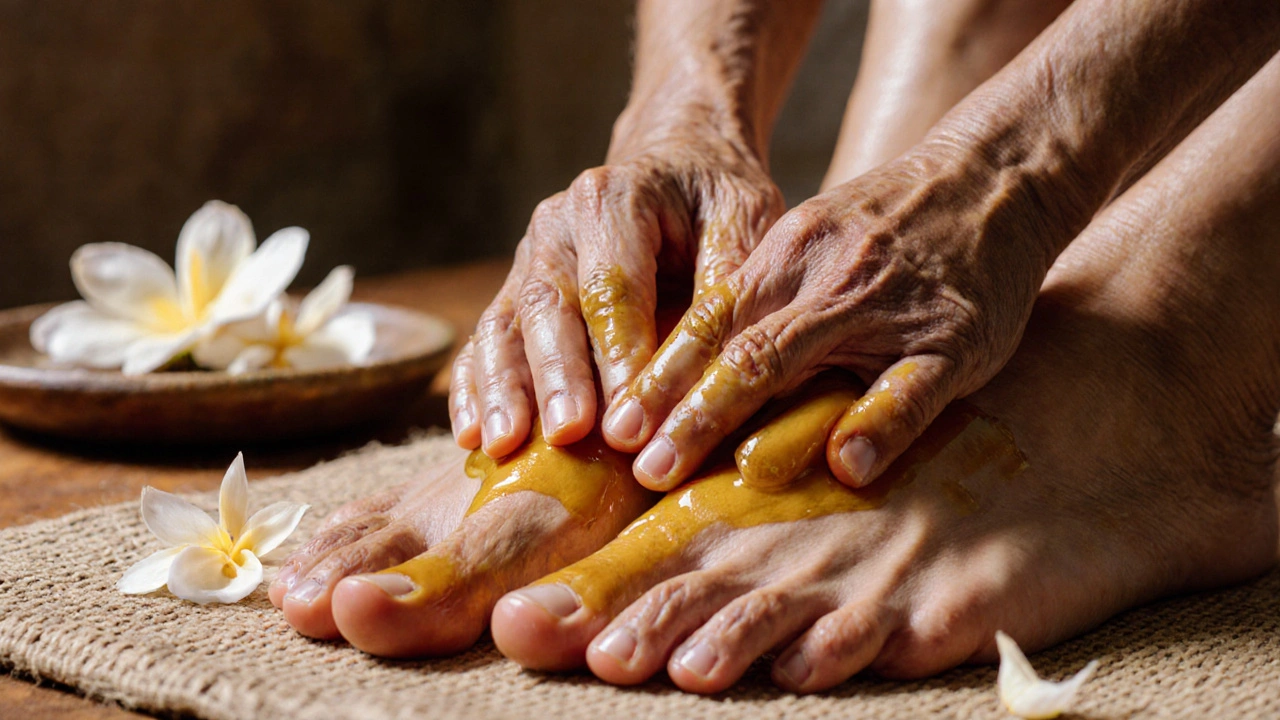Unwind and Rejuvenate with a Balinese Massage: A Full Guide to Its Benefits and Techniques
 Nov, 16 2025
Nov, 16 2025
Balinese Massage Frequency Estimator
Find your ideal Balinese massage schedule based on your wellness goals. This tool provides recommendations based on clinical guidelines and traditional Bali practices.
Recommended Schedule
Once per month
Session length: 60-90 minutes
Imagine lying on a warm mat, the scent of frangipani and lemongrass curling through the air, as gentle pressure moves along your muscles like waves rolling onto a beach. This isn’t a vacation fantasy-it’s a Balinese massage, a centuries-old healing practice that’s now bringing deep calm to people in cities from Salt Lake City to Sydney.
What Exactly Is a Balinese Massage?
A Balinese massage isn’t just one technique-it’s a blend of five traditional healing methods passed down through generations in Bali, Indonesia. It combines acupressure, reflexology, aromatherapy, gentle stretching, and long flowing strokes. Unlike Swedish massage, which focuses mostly on relaxation, or deep tissue, which targets chronic tension, Balinese massage works on your whole system: muscles, energy flow, and nervous system.
Therapists use their thumbs, palms, elbows, and sometimes even forearms to apply rhythmic pressure. They often start at the feet and work upward, following the body’s natural energy lines called meridians. Essential oils-usually made from local plants like ginger, turmeric, and jasmine-are warmed and massaged into the skin. These aren’t just for smell; they have anti-inflammatory and calming properties backed by traditional use and modern studies.
Why It Works Better Than Other Massages for Stress
If you’ve tried a Swedish massage and still felt tense afterward, you’re not alone. Many people report that Balinese massage hits a deeper reset button. Why? Because it doesn’t just relax muscles-it calms the nervous system.
A 2023 study published in the Journal of Integrative Medicine found that participants who received a 60-minute Balinese massage showed a 34% drop in cortisol levels-the main stress hormone-compared to a 17% drop in those who got a standard Swedish massage. The difference? The combination of rhythmic pressure, aromatic oils, and mindful pacing triggers the parasympathetic nervous system more effectively.
People who deal with anxiety, insomnia, or burnout often describe it as feeling “unwound.” One client from Denver said, “After three sessions, I stopped needing my nightly melatonin. My body finally remembered how to rest.”
The Key Ingredients and Their Real Effects
What makes Balinese massage unique isn’t just the technique-it’s the oils. Here’s what you’re actually getting under your skin:
- Frangipani oil - Derived from the flower of the same name, it’s rich in antioxidants and has been used for centuries to soothe skin irritation and promote circulation.
- Ginger oil - Warms the muscles and reduces inflammation. Studies show it’s as effective as ibuprofen for joint stiffness, without the side effects.
- Turmeric oil - Contains curcumin, which helps reduce muscle soreness and supports recovery after physical activity.
- Jasmine absolute - Not just fragrant; research links its scent to lowered heart rate and improved mood within minutes of inhalation.
These aren’t just trendy add-ons. In Bali, these oils are made fresh daily by local families using traditional cold-pressing methods. That’s why massaging with them feels different than using synthetic fragrance oils you find in spas elsewhere.

What to Expect During Your First Session
Most sessions last between 60 and 90 minutes. You’ll lie on a padded mat on the floor-not a table-wearing loose, comfortable clothing or nothing at all (draped with towels). The room is dimly lit, often with soft music or the sound of running water.
Here’s the typical flow:
- Centering - The therapist may place a warm stone on your lower back or offer a few deep breaths with you to help you settle in.
- Foot and leg work - Starts at the soles of your feet, using thumb pressure on reflexology points linked to organs and glands.
- Back and shoulder focus - Long, flowing strokes followed by deeper circular pressure on knots. This is where most people feel the first wave of release.
- Arm and neck - Gentle stretches are added here to release tension held from hunching over desks or phones.
- Final oil application - Warm oil is gently patted into the skin, leaving a light sheen that continues to absorb for hours.
You won’t be asked to grunt or hold your breath. There’s no cracking of joints or aggressive force. It’s slow, steady, and intentional. Many people fall asleep during the back work-don’t worry, that’s normal.
Who Should Try It-and Who Should Skip It
Balinese massage is safe for most people. But it’s not for everyone.
Great for:
- People with chronic stress or anxiety
- Those with stiff shoulders from desk work or phone use
- Anyone recovering from mild muscle strain (not injuries)
- People seeking natural alternatives to painkillers
- Those who feel emotionally drained but can’t pinpoint why
Not recommended for:
- People with open wounds, burns, or recent surgeries
- Those with severe osteoporosis or blood clotting disorders
- Women in early pregnancy (after the first trimester, it’s generally safe with a trained prenatal therapist)
- Anyone allergic to coconut, ginger, or citrus oils (ask for oil substitutions)
If you’re unsure, talk to your therapist. A good one will ask about your health history before you even lie down.
How to Find a Real Balinese Massage Experience
Not every “Balinese massage” is authentic. Many spas slap the name on a standard Swedish routine with a few drops of essential oil. Here’s how to spot the real thing:
- Ask if the therapist trained in Bali or with a certified Balinese lineage. Many authentic therapists come from Bali and have trained under family lineages.
- Check the oils. Authentic sessions use pure, cold-pressed oils-not fragrance blends. Ask to smell them before the session.
- Look for a quiet, earth-toned room with natural materials. The setting matters as much as the technique.
- Expect a longer session. Real Balinese massage takes at least 60 minutes. Anything shorter is usually a watered-down version.
- Price point: In the U.S., expect $85-$140 for a 60-90 minute session. If it’s $40, it’s likely not authentic.
Look for therapists who mention specific techniques like urut (Balinese for massage) or refleksiologi (reflexology). These terms are rarely used by fake providers.

How Often Should You Get One?
There’s no one-size-fits-all answer, but here’s a practical guide:
- For stress relief: Once a month keeps cortisol levels balanced.
- For chronic tension: Every 2-3 weeks for 2-3 months, then taper to monthly.
- For recovery after travel or illness: One session right after returning home can reset your system.
- For maintenance: Every 6-8 weeks helps prevent buildup.
Unlike chiropractic care or physical therapy, Balinese massage doesn’t require a long-term plan. It’s more like eating well or sleeping enough-something you return to because it feels right.
What Happens After the Massage?
Don’t rush off. The effects continue for hours-even days. You might feel:
- Light-headed (drink water-this is normal)
- Extra sleepy (plan a quiet evening)
- A slight ache in areas that were tight (this means the massage worked)
- A sudden sense of clarity or emotional release
Some people cry. Others laugh. It’s not unusual. The massage doesn’t just touch your body-it releases stored tension that’s been held emotionally.
After your session, avoid caffeine, alcohol, and heavy meals for at least 3 hours. Take a warm shower-not hot-to help the oils absorb. Wear loose clothes. Let your body stay quiet.
Why It’s More Than Just a Massage
Balinese massage isn’t just about muscle relief. It’s a ritual. In Bali, it’s often part of a larger healing ceremony-sometimes paired with meditation, prayer, or herbal baths. Even when practiced in a U.S. spa, the intention remains: to restore balance.
It’s not magic. But it’s science-backed, culturally rich, and deeply human. In a world that’s always pushing us to do more, this massage asks you to simply be. And sometimes, that’s the most healing thing of all.
Is Balinese massage painful?
No, it shouldn’t be painful. The pressure is firm but never sharp or bruising. If you feel pain, speak up. A good therapist will adjust immediately. The goal is deep relaxation, not discomfort.
Can I get a Balinese massage if I’m pregnant?
Yes, but only after the first trimester and only with a therapist trained in prenatal Balinese massage. They’ll avoid certain pressure points and use side-lying positions for safety. Always inform them you’re pregnant before the session.
How long do the effects last?
Most people feel relaxed for 2-5 days. The deeper benefits-like reduced muscle stiffness and better sleep-can last weeks if you get regular sessions. The oils continue to absorb for up to 12 hours after the massage.
Do I need to shower before or after?
Shower before if you’ve been sweating or wearing strong perfume. After, take a warm-not hot-shower to help the oils penetrate. Avoid scrubbing your skin for 6-8 hours to let the therapeutic ingredients work fully.
Can I do Balinese massage at home?
You can mimic some elements-like using ginger or jasmine oil with slow, rhythmic strokes-but the full technique requires training. The pressure, timing, and energy flow are hard to replicate alone. For best results, get it done professionally at least once a month.
